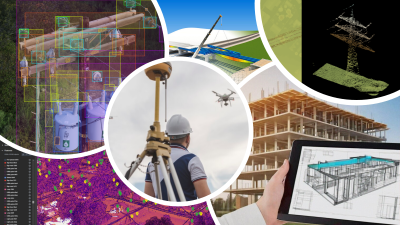The geospatial industry, like so many others with technology at its center, is a whirlwind of innovation. It seems like on a monthly basis there is some new technology or technique being introduced that sparks the imagination of the entire sector. Whether it be new hardware, updated versions of previous systems, or, in today’s world, new software capabilities powered by artificial intelligence, there are thrilling developments happening constantly.
In practice, what that means is that we are in a world with more ways to collect data than ever before, giving us more streamlined capabilities for construction and engineering work, better systems for streamlined life in urban areas, and just generally more information about our planet than we’ve ever had. There is data coming in from a number of different types of sources, and more people than ever have the ability to both collect said data and find a need to interact with it. By and large, this is clearly a positive as having more information on which important decisions can be based can never be seen as a bad thing.
However, that is not the same as saying these developments come without complications. Even before all of this innovation, the geospatial industry and those that interact with it are built around massive amounts of data needing to be shared among different stakeholders. This in and of itself always has a chance to make things needlessly complex, if not entirely untenable. It’s because of this that standards are so important, and why in the geospatial and AEC industries there are so many.
It goes without saying that, frankly, this is not the most interesting topic in the world. The great thing for workers in this industry is that they are able to spend a significant amount of their time outdoors, often in scenic areas, and/or working to create tangible assets that will serve the greater good, all while working with the aforementioned technology. But as anyone who has been in this industry will also tell you, none of this works without standards.
To put it succinctly, standards are what enables interoperability and data sharing throughout the industry. Everyone knows that there are many different platforms – for both hardware and software – in this industry, and not everyone is using the same thing. Standards ensure that this data is able to work together, and thus the professionals involved are able to do the same thing.
There are a few different areas of standards that are worth going over in this article, starting with those set by the Open Geospatial Consortium. On a personal note, my first ever interview in this industry was with Dr. Nadine Alameh, who at the time was the CEO and President with the OGC and is currently the Executive Director for the Taylor Geospatial Institute.
Still learning some of the technology at that time, there was admittedly much in that conversation that went over my head, but what stood out the most was her, and by extension the OGC’s, attitude around openness. In short, it is the key to a functioning geospatial industry, and it’s the ethos behind their standards. They believe that the most successful and impactful geospatial sector is one that shares amongst itself and works together, something that doesn’t happen without standards.
You can read through all of OGC’s standards here, but the backbone of it all is the idea of FAIR geospatial information – Findable, Accessible, Interoperable, and Reusable. The OGC is constantly updating and adding to their standards, having released a series of updates to their standards just last week. Not every professional needs to know every standard – and some even benefit from standards they don’t know about – but having this kind of dedicated organization working behind the scenes to create these crucial components to the industry is what makes everything work smoothly.
Alongside OGC standards, ISO/TC 211 standards are crucial for the industry as well. A bit more formal, the ISO isn’t just a geospatially focused organization, but rather one that develops standards for a variety of industries. This isn’t to say that OGC doesn’t put tremendous care into their standards, but the process is more collaborative in nature, taking input from different insiders and organizations in a more open setting.
ISO standards, on the contrary, take longer to go through as they generally face a multi-step review, often taking years to be formalized. These are, however, crucial standards for the industry, with standards around metadata to describe geographic information and services, spatial referencing using coordinate systems, and service metadata and models.
Ultimately, while there are key differences in these standards – not to mention other standards in the industry, such as those that govern BIM usage and those from ASTM, who developed the E57 3D file format – all of these are crucial for the sector as a whole. It’s these standards, as unexciting as they may be at times, that allow for crucial work to be done across platforms, professions, and end users, and without them the geospatial industry simply would not be able to function.






